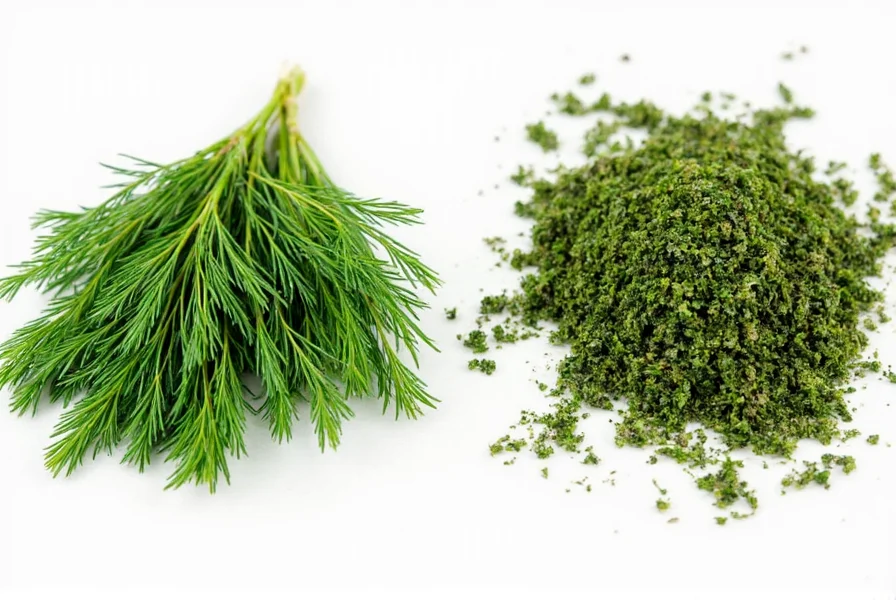Table of Contents
Introduction
Dill and dill weed come from the same plant, Anethum graveolens, but they are different parts with distinct uses. Dill refers to the entire plant including seeds and fresh leaves, while dill weed specifically means the dried leaves. This guide explains everything you need to know to use them correctly in cooking.
What's Dill? The Whole Plant Breakdown
The term "dill" refers to the entire plant (Anethum graveolens), which includes both leafy parts and seeds.
- Dill Seeds: Dried fruits used as spice in pickling, breads, and stews.
- Fresh Dill: Feathery green leaves (dill fronds), delicate and aromatic.
Commonly used in Eastern European, Mediterranean, and Middle Eastern cuisines. Store-bought fresh dill typically means leafy parts only.
What's Dill Weed? A Flavorful Leafy Secret
Dill weed is the dried form of dill leaves, not a separate species. The name "weed" comes from Old English "wéod" meaning plant/herb.
- Made by drying dill leaves only
- Sold in spice jars for seasoning blends, soups, and sauces
- Flavor is more concentrated than fresh dill but less vibrant
Can substitute for fresh dill with adjustments: use 1 tsp dill weed for every 1 tbsp fresh dill.
Head-to-Head Comparison: Dill vs Dill Weed
Detailed comparison table for kitchen use:
| Feature | Dill (Fresh or Whole Plant) | Dill Weed |
|---|---|---|
| Part of the Plant | Leaves, stems, seeds | Dried leaves only |
| Form | Fresh or dried | Dried |
| Flavor Intensity | Mild, bright, herbaceous | Stronger, more concentrated |
| Cooking Time | Add near end of cooking | Can be added earlier; withstands heat better |
| Best Uses | Garnishes, salads, sauces, fish | Pickling, soups, dressings, baked goods |
| Shelf Life | Short (fresh), several months (dried) | 6–12 months if stored properly |
Cooking Tips: When to Use Each
- Use fresh dill for garnishes, salads, dips (tzatziki), or last-minute freshness
- Substitute dill weed for fresh dill: use 1 tsp dill weed per 1 tbsp fresh dill
- Pickling: Use dill seeds or fresh dill heads for robust flavor; dill weed works but use sparingly
- Baking: Dill weed integrates well in savory breads without adding moisture
Buying Guide: How to Choose the Right One
Fresh Dill Tips
- Color: Bright green, no yellow/brown
- Texture: Perky and firm leaves
- Smell: Fresh grassy aroma (avoid musty)
- Storage: Place in water like cut flowers, refrigerate with plastic cover
Dill Weed Tips
- Packaging: Airtight containers
- Color: Vibrant green (not dull/brown)
- Label: Must say "dill weed" (not just "dill")
- Brand: Reputable with clear expiration dates
Frequently Asked Questions
What's the difference between dill and dill weed?
Dill refers to the entire plant including seeds and fresh leaves, while dill weed specifically means the dried leaves. Fresh dill is sold in produce sections; dill weed is dried and sold in spice aisles.
Can I substitute dill weed for fresh dill?
Yes, but adjust quantities: use 1 tsp dill weed for every 1 tbsp fresh dill. Add dill weed earlier in cooking; fresh dill should be added near the end.
What's stronger, dill or dill weed?
Dill weed (dried leaves) has stronger, more concentrated flavor than fresh dill. Fresh dill has brighter herbal notes that diminish when dried. Dill seeds have a different, stronger profile.
Is dill weed the same as dried dill?
Yes, "dill weed" is the culinary term for dried dill leaves. "Weed" comes from Old English "wéod" meaning plant/herb, not an unwanted plant.
What can I use if I don't have dill weed?
Substitute with fresh dill (3x amount), dill seeds (half amount, different flavor), or herbs like tarragon or fennel fronds.
Why is it called dill weed if it's not a weed?
The term "weed" comes from Old English "wéod" (plant/herb), not the modern meaning of unwanted plant. This naming convention applies to other herbs like chamomile weed.
How do I store fresh dill to make it last longer?
Trim stems, place in glass with water, cover loosely with plastic bag, refrigerate. Change water every few days for 7-10 days freshness.
Which is better for pickling, dill or dill weed?
For traditional pickling, use fresh dill heads (flower clusters) or dill seeds for robust flavor. Dill weed works in a pinch but use sparingly to avoid overpowering.
Conclusion
Dill and dill weed come from the same plant but serve different culinary roles. Use fresh dill for vibrant garnishes and delicate dishes, and dill weed for concentrated flavor in cooked applications. Mastering their differences ensures perfect seasoning in every recipe.











 浙公网安备
33010002000092号
浙公网安备
33010002000092号 浙B2-20120091-4
浙B2-20120091-4